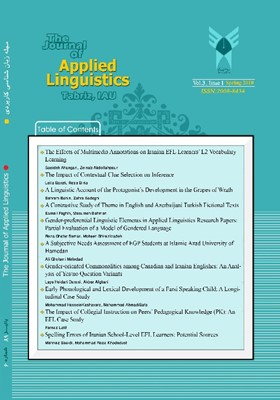The Impact of Contextual Clue Selection on Inference
الموضوعات :
1 - Khorasgan Branch, Islamic Azad University, Khorasgan, Iran.
2 - Khorasgan Branch, Islamic Azad University, Khorasgan, Iran.
الکلمات المفتاحية: Listening comprehension, inference, Contextual Clue, Mental Knowledge,
ملخص المقالة :
Linguistic information can be conveyed in the form of speech and written text, but it is the content of the message that is ultimately essential for higher-level processes in language comprehension, such as making inferences and associations between text information and knowledge about the world. Linguistically, inference is the shovel that allows receivers to dig meaning out from the text with selecting different embedded contextual clues. Naturally, people with different world experiences infer similar contextual situations differently. Lack of contextual knowledge of the target language can present an obstacle to comprehension (Anderson & Lynch, 2003). This paper tries to investigate how true contextual clue selection from the text can influence listener’s inference. In the present study 60 male and female teenagers (13-19) and 60 male and female young adults (20-26) were selected randomly based on Oxford Placement Test (OPT). During the study two fiction and two non-fiction passages were read to the participants in the experimental and control groups respectively and they were given scores according to Lexile’s Score (LS)[1] based on their correct inference and logical thinking ability. In general the results show that participants’ clue selection based on their personal schematic references and background knowledge differ between teenagers and young adults and influence inference and listening comprehension. [1]- This is a framework for reading and listening which matches the appropriate score to each text based on degree of difficulty of text and each text was given a Lexile score from zero to four.
Adams, M. (2002). Teaching English. Journal of English Linguistics, 30 (4) 353-365.
Adams, M. (2003). Language as a natural object, Phonetics Investigation Aspect. The Linguistic Review, 22, 447-466.
Anderson, K., & Lynch, T. (2003). Learner/non-teacher interactions: the contribution of a course assistant to EAP speaking classes. Interaction and Language Learning (pp. 7-22). TESOL Case Studies in Practice series. Alexandria, VA: TESOL.
Bada, A., & Gence, H., (2005). The Cognitive Academic Language Learning Approac (CALLA). In P.A. Academic success for English language learners (pp. 87-101). White Plains, NY: Longman.
Bloom, P. (2000). How children learn the meaning of words. Cambridge, MA: 85MIT Press.
Bowyer, C. Crane, T., & Snowling, M. (2005). Assessing children inference generation: True What do tests of reading comprehension measure? British Journal of Educational, Psychology, 75, 189-201.
Boynton, A., & Blevins, W. (2003). Teaching Students to Read Nonfiction. First Reviewing:M
Duke, N. (2003). The scarcity of informational texts in first grade. Reading Research Quarterly, 35(2), 202-204.
Graesser, A., Singer, M., & Trabasso, D. (1994). Coh-Metrix: Discourse Perspective on the Comprehension ability. 42, 104-125.
Happe, F., & Loth, E. (2002). Theory of mind and tracking speaker’s intentions. Mind and the Language, 17, 24-36.
Hoyt, L., Mooney, M., & Parkes, B. (2003). Part 1: Bringing informational texts into focus. Exploring informational texts. From theory to practice (p. 1). Portsmouth, NH: Heinemann.
Kamil, M., & Lane, D. (2005). Using information text for first grade reading instruction: Theory and practice. Retrieved August 5, 2005, from http://www.stanford.edu/ TT, 987C mkamil/nrc97b.htm
Keene, E., & Zimmerman, S. (1997). Mosaic of thought: Teaching comprehension in a reader 's workshop. Portsmouth, NH: Heinemann. University Massachusetts press.
Leslie, L., & Caldwell, J. (2008).Social linguistics and literacies: Ideology in discourses, New Formal and informal measures of reading. Princeton University, Princeton, NJ 08544, 230-331.
Lynch, T. (2002). Theoretical Perspectives on Listening. Annual Review of General Applied Linguistics, 3-19.
McCormick, S., & Hill, D. S. (2001). An analysis of the effects of tow procedures for increase disabled readers’ inferencing skills. Journal of Educational Research, 77, 219-226.
Mish, F. (2005). Merriam-Webster’s collegiate dictionary (11th ed.). Spring field, In MA: Merriam-Webster, Inc.
Nesset,T.(2008). Cognitive Knowledge and Grammar: A basic introduction. Journal of Hum Linguistics, 45(2) s. 477-480.
Nunan, D. (2007). Applied Linguistics Discourse Analysis Review London: Penguin books.
Richards, J. C., & Anderson, N. A. (2005). How do you know? A strategy to help emergent in readers make inferences. The Reading Teacher, 57, 290-293.
Rost, M. (2002). Teaching and Researching Listening. England: Pearson Education Ltd.
Sapir, E. (1989). Language: An introduction to the study of speech. New York: Harcourt, Brace and company.
Scharer, P., Pinnell,S., Lyons, C., & Fountas, I. (2005). Becoming an engaged reader. Learning Educational Leadership, 63(2), 24-29. Few 1245,Tree in this Retrieved from http://www.ascd.org/portal/site/ascd/menuitem.a4db.
Sperber, D. Wilson, D.,(2005). Relevance,communication and cognition (2nd ed.). Oxford: Blackwell.
Wagner, D. T. (2006). How knowledge helps. [Online] Available: http://www.aft.org/pubs-reports/american_educator/issues /spring06/willingham.htm
Wasik, M., & Bond, T. (2001). Young children's storybook reading: Longitudinal study of the parent-child interaction and children's independent functioning (Final report to the Spencer Foundation). Ann Arbor: University of Michigan. ED 334 541.
Whitehurst, J., & Lonigan, P. (1998). Emotion in Text: Evolution, Development, and Simuly of Everyday Mindreading. Oxford: Blackwell.
Wright, D. (2000).Language development in the pre-school years. Cambridge: Cambridge University Press.


